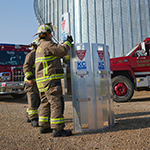Prevent feed accidents
Learn top feed-related issues and tips to avoid risk to animals.
Feeding livestock requires careful management. Mold and mildew can be producers’ worst enemies as they work to keep livestock healthy. Jay Bexell, Nationwide agribusiness claims specialist, shares his list of the top feed-related issues he runs across and some tips to help producers avoid problems.
1. Look for the label
This isn’t generally a problem if a producer purchases bag feed, but if you have bulk feed or feed supplements delivered, Bexell advises, “If it doesn’t have a label, don’t accept it and, even more importantly, don’t use it.”
Labels will also specify what type of animal the feed is intended for. Without a label, you can’t verify the correct feed was delivered. Make sure to always read and follow label instructions.
2. Visually inspect the feed on delivery
Use your senses and your instincts to check the feed or feed supplement that was delivered immediately. “Is the feed the same texture you’ve used? Is it the same color, the same odor? Is it what you expected to receive?” Bexell says. “If there are any variances in what you had expected, double check with your feed provider.”
When new feed has been delivered, carefully watch your animals’ reaction to it. Are they freely consuming or do they seem picky or balk at the feed trough? Any negative reaction by your animals is a red flag. Stop feeding the product immediately and contact your feed provider.
3. Designate a specific delivery location
Many producers feed a variety of animals (e.g., cattle, hogs, horses and sheep). Copper is toxic for sheep and llamas. Lonophore antibiotics, a common feed medication additive, is tolerated well by cattle at correct dosage levels, but can be deadly for horses. So it’s critical for producers to know which feed is stored where.
Bexell recommends marking all feed storage facilities on your operation. “Use large placards on the buildings or bins. Number them or use letters,” Bexell advises. “That way you can tell your feed supplier to deliver to Bin C, for example.”
4. Perform housekeeping
- Housekeeping both at your operation and at the feed production facility is critical to the quality of feed you receive and feed to your animals.
- Proper rotation — Be sure you’re using older feedstock first so the feed is rotating and not degrading.
- Consistent cleaning — Regularly inspecting and cleaning feed-storage facilities as well as feed-delivery systems (augers, conveyers) is critically important for mold, mildew and mycotoxin control. “Don’t let old feed accumulate in corners or inaccessible areas,” Bexell advises. “It’s worth the investment of time and energy for your animals’ health to be vigilant about this.”
- Feed storage must be weather-tight — Make sure your feed stays dry. Moisture or condensation promotes mold and mildew growth.
- Control vermin — Keep mice, insects, birds, bats and other rodents out of the feed.
5. Rotate feedstock
For livestock producers who blend or mix purchased feed with their own hay, feedstock or silage, be sure your own feedstocks also are rotated and stay in good condition.
6. Agitate liquid feed supplements
It is very important that liquid feed supplements be properly agitated. Some products contain medications and should be agitated daily, whether it’s being actively used or not. If not properly agitated, liquid feed supplements can separate into stratified layers, causing uneven presentation to animals, and possibly toxic dosages in some situations. Again, always read and follow label directions.
7. Provide proper sources for water
Most livestock producers also provide water at feed locations, a smart move for their livestock. If you do, you’ll want to ensure there is plenty of water and stall space for the number of livestock feeding. “Pay attention to the housekeeping in your feedbunks, too,” Bexell advises. “And be sure there’s enough room for all livestock to access the feedbunks as well.”
In general, Bexell recommends producers use a diary or journal to document feed deliveries and any issues encountered. Watch for and manage any problems immediately. “It could be as simple as a checklist format to help you keep track,” he says.

 >
>

 >
>
 >
>